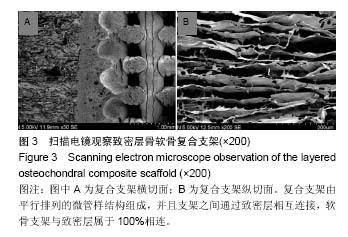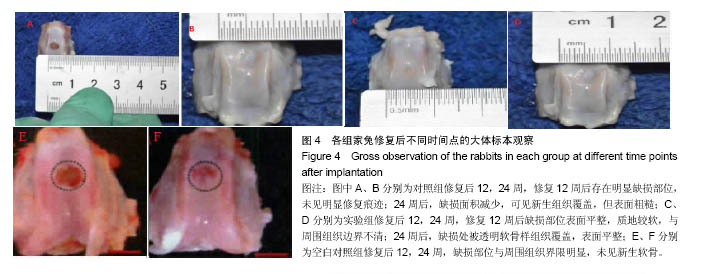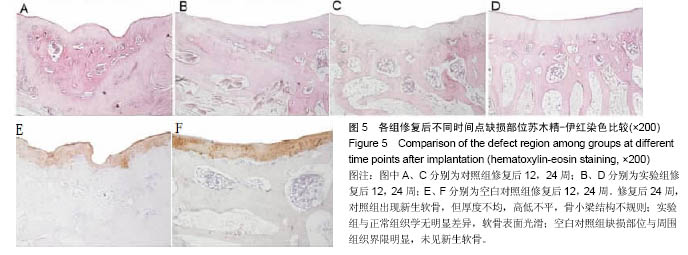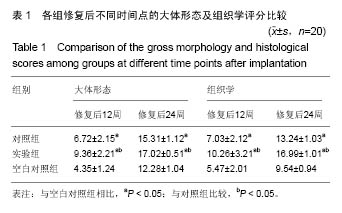中国组织工程研究 ›› 2017, Vol. 21 ›› Issue (2): 197-201.doi: 10.3969/j.issn.2095-4344.2017.02.007
• 组织工程骨及软骨材料 tissue-engineered bone and cartilage materials • 上一篇 下一篇
致密层骨软骨复合支架的制备及其修复关节骨软骨缺损
魏 戎1,武军龙1,吴飞翔1,王 超1,刘娟娟1,吴晴缘2
- 1郑州大学附属洛阳中心医院,河南省洛阳市 471000;2河南大学第一临床学院,河南省开封市 475001
Preparation and application of layered osteochondral composite scaffold in the repair of articular cartilage defects
Wei Rong1, Wu Jun-long1, Wu Fei-xiang1, Wang Chao1, Liu Juan-juan1, Wu Qing-yuan2
- 1Luoyang Central Hospital Affiliated to Zhengzhou University, Luoyang 471000, Henan Province, China; 2the First Affiliated Hospital of Henan University, Kaifeng 475001, Henan Province, China
摘要:
文章快速阅读:
.jpg)
文题释义:
致密层骨软骨复合支架:参考关节骨软骨的解剖结构、生理功能制备致密层骨软骨复合支架,采用低温沉积制造工艺在三维立体包芯结构骨架上形成致密层,并且利用“溶解粘连”技术将定向微管结构骨支架与致密层进行严密的结合,从而成功制备了致密层骨软骨复合支架。
致密层骨软骨复合支架的表征:支架直径为5 mm,厚度为2 mm,孔径为(9.2±2.3) μm,孔隙率为(3.2±0.5)%,吸水率为(2.8±0.2)%,扫描电镜显示制备的致密层骨软骨复合支架由平行排列的微管样结构组成,并且支架之间通过致密层相互连接,软骨支架与致密层属于100%相连。
背景:理想的骨软骨组织工程支架应巧妙地模拟人体正常关节骨软骨结构。
目的:基于关节骨软骨的解剖结构、生理功能,制备致密层骨软骨复合支架,同时观察其修复兔关节骨软骨缺损的效果。
方法:利用快速成型技术在三维立体包芯结构骨架表面喷涂乳酸-羟基乙酸共聚物/β-磷酸三钙有机溶液,形成 0.5 mm的致密层;利用“溶解-粘连”工艺能将定向微管结构软骨支架与致密层相互连接,形成致密层骨软骨复合支架。取60只家兔,制备左膝关节软骨全层缺损,随机分3组,实验组植入致密层骨软骨复合支架,对照组植入定向微管结构软骨支架,空白对照组不植入任何材料,修复后12,24周进行缺损部位大体与组织学观察。
结果与结论:①大体观察结果:对照组修复后12周存在明显缺损部位,未见明显修复痕迹;24周缺损面积减少,可见新生组织覆盖,但表面粗糙。实验组修复12周后缺损部位表面平整,质地较软,与周围组织边界不清;修复后24周,被透明软骨样组织覆盖,表面平整。空白对照组修复效果较差;②组织学观察结果:修复后12周,对照组缺损部位出现形态不规则的骨痂,但未形成骨小梁;实验组出现新生骨,软骨厚度与正常软骨接近,并且软骨下存在不规则骨小梁。修复后24周,对照组出现新生软骨,但厚度不均,高低不平,骨小梁结构不规则;实验组组织与正常组织无明显差异,软骨表面光滑;空白对照组修复效果较差;③结果表明:致密层骨软骨复合支架接近人体正常关节骨软骨结构,可促进关节软骨缺损的修复。
中图分类号:




.jpg)
.jpg)
.jpg)